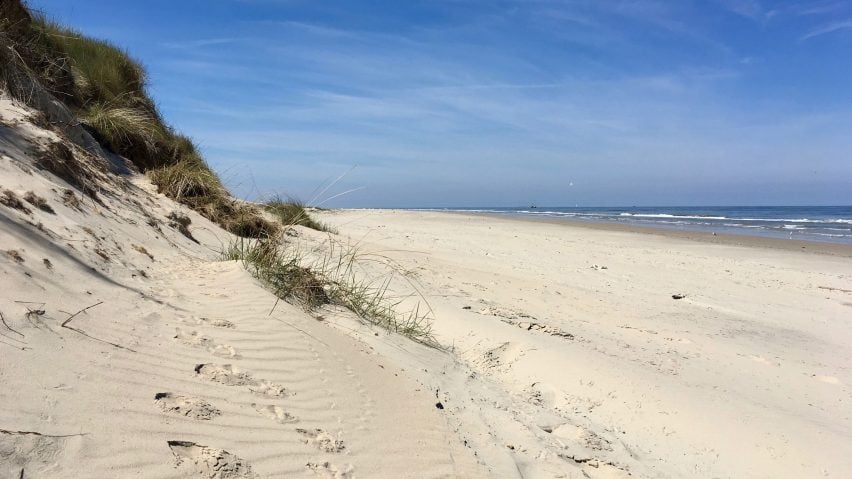A symposium taking place at Dutch Design Week later this month will discuss the rapid depletion of the world's sand reserves, which could leave supplies of the high-quality sand used in the glass industry exhausted within 20 years.
The "sand crisis" threatens to destabilise the global glassmaking and concrete industries, with the latter using an estimated 25 billion tons of sand and gravel every year.
On top of this, up to 50 billion tons per year gets trapped behind the growing number of dams around the world, which prevent rivers carrying new deposits downstream.
Meanwhile illegal sand mining is destroying fragile landscapes around the world.
"We may not run out of it, but it will become increasingly scarce and expensive," according to British geologist Michael Welland, whose 2009 book Sand explores a material widely considered to be limitless but which is now emerging as a threatened resource.
Sand is one of the world's most important raw materials
Welland is among the speakers at the symposium taking place in Eindhoven on 27 October, which will discuss the granular substance.
"Sand is the most consumed resource on earth after freshwater," said Dutch design duo Atelier NL, who have organised the symposium.
Besides glass and concrete, sand is also a critical ingredient in computer chips, meaning it is one of the key raw materials of the modern world.
"As the urbanisation of our modern world expands, so does the need for this unassuming resource," wrote Nadine Sterk and Lonny van Ryswyck of Atelier NL, who are this year's Dutch Design Week ambassadors, alongside architect Winy Maas of MVRDV and Marcus Fairs of Dezeen.
"Yet sand is being excavated at a rate faster than it can renew itself," they said. "It is disappearing from shorelines, rivers and sea beds, causing disastrous effects for both environmental and human systems."
Most glassmakers only use one type of of sand
Sterk and Van Ryswyck have convened the symposium as part of a project called To See The World in a Grain of Sand, which saw them call on people to send them bottles of sand from different corners of the world.
The duo have used these "wild" sand samples to make glass samples that vary according to the mineral composition and texture of the source material. The resulting glass will be exhibited at Dutch Design Week.
"We are raising awareness," said Van Ryswyck. "The project will become an archive in future when sands are disappearing, and we are going to have a discussion about the sand crisis."
A senior figure from the luxury glass industry who did not want to be named told Dezeen that there was only around 20 years' supply remaining of the fine white silica sand his craftsmen need.
Van Ryswyck said that glassmakers could instead learn to work with other types of sand, which are still abundant.
"The glass industry is only using white sand," she said. "Why are they not using other types of sand in the glass industry? All the glassblowers are using the same granules, which are provided by big companies. They don't prepare their own sand."
Only 20 years worth of white sand remains
Welland described the fine sands commonly used to make glass as "a good example of an exhaustible specialty sand whose availability is unsustainable," but said it is "impossible to quantify" how much remains in the world.
"Perhaps [there is] 20 years [supply] of the known high-purity glass sand deposits, but more will be found with increasing difficulty and expense," he said.
Other industries that rely on specialist sands could also face shortages in future.
"You can't use any old sand to make concrete," said Welland, explaining that desert grains are too smooth to be useful for concrete. "Dubai, on the edge of its vast desert, had to import sand from Australia for its mega construction projects."
He added: "You can't take ordinary beach sand and make optical-quality glass out of it. You can't take desert sand and make concrete out of it. Golf course developers demand sand with specific qualities for their bunkers. The controversial process of fracking to produce oil and gas requires huge quantities of sand that is only found in certain places.
"And yes, most sand is made of the mineral quartz, silica, but then there are the mineral sands – iron, platinum, gold, diamonds, titanium and so on – that are critical to our way of life and our economy."
Sand mining regulations are difficult to enforce
French filmmaker Denis Delestrac, who made the 2013 documentary Sand Wars, will also speak at the symposium in Eindhoven.
"The world is running out of sand, consumed by industry and construction, stolen and transported by criminal mafias across the world," the film's blurb says.
Welland described sand as "a global commodity trade on an epic scale," which much of this trade being conducted illegally.
"Even where sand mining and dredging regulations exist they are often impossible to enforce," he said. "In many parts of the world, sand, as a resource, has a unique quality: it's apparently free."
Gangs strip beaches and river beds of their sand and sell it to illegal dealers, he said. "India cannot put a policeman on every beach and river bank – and, when they do, the ferociousness of the sand-mafia trade has led to violence and death. Meanwhile, the local ecosystem and the local society's way of life is ruined."
"Our projects don't start with 'we want to save the world'," said Van Ryswyck. "They start with a fascination with a beautiful material. But the more you look into it, you understand this material is so valuable."
The Abundance and Scarcity of Sand symposium takes place at MU, Torenallee 40-06, 5617BD Eindhoven, on Friday 27 Oct 2017 at 8pm.
Dezeen is hosting a series of talks at Dutch Design Week titled Good Design for a Bad World, which will explore how designers can help solve the big problems facing the world.

